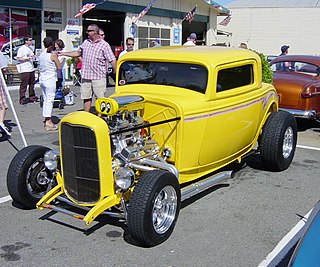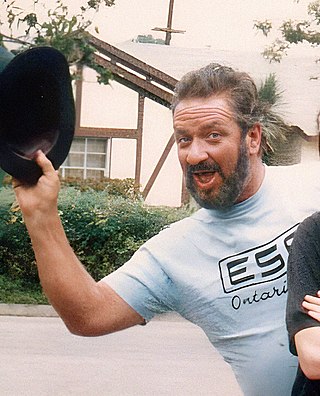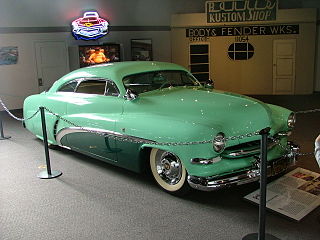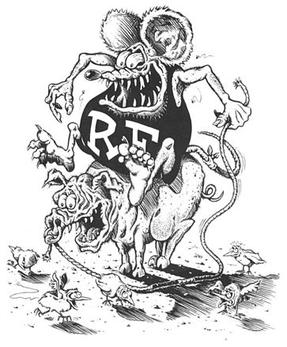
A lowrider or low rider is a customized car with a lowered body that emerged among Mexican American youth in the 1940s. Lowrider also refers to the driver of the car and their participation in lowrider car clubs, which remain a part of Chicano culture and have since expanded internationally. These customized vehicles are also artworks, generally being painted with intricate, colorful designs, unique aesthetic features, and rolling on wire-spoke wheels with whitewall tires.

Hot rods are typically American cars that might be old, classic, or modern and that have been rebuilt or modified with large engines optimized for speed and acceleration. One definition is: "a car that's been stripped down, souped up and made to go much faster." However, there is no definition of the term that is universally accepted and the term is attached to a wide range of vehicles. Most often they are individually designed and constructed using components from many makes of old or new cars, and are most prevalent in the United States and Canada. Many are intended for exhibition rather than for racing or everyday driving.

Raggare is a subculture found mostly in Sweden and parts of Norway and Finland, and to a lesser extent in Denmark, Germany, and Austria. Raggare are related to the American greaser and rockabilly subcultures and are known for their love of hot rod cars and 1950s American pop culture. Loosely translated into English, the term is roughly equivalent to the American "greaser", English "rocker", and Australian "Bodgie" and "Widgie" culture; all share a common passion for mid-20th-century American cars, rockabilly-based music and related fashion.
Juxtapoz Art & Culture Magazine is a magazine created in 1994 by a group of artists and art collectors including Robert Williams, Fausto Vitello, C.R. Stecyk III, Greg Escalante, and Eric Swenson to both help define and celebrate urban alternative and underground contemporary art. Juxtapoz is published by High Speed Productions, the same company that publishes Thrasher skateboard magazine in San Francisco, California.

George Barris was an American designer and builder of Hollywood custom cars. Barris designed and built the Hirohata Merc. Barris's company, Barris Kustom Industries, designed and built the Munster Koach and DRAG-U-LA for The Munsters; and the 1966 Batmobile for the Batman TV series and film.

Ed "Big Daddy" Roth was an American artist, cartoonist, illustrator, pinstriper and custom car designer and builder who created the hot rod icon Rat Fink and other characters. Roth was a key figure in Southern California's Kustom Kulture and hot rod movement of the late 1950s and 1960s.

Pin striping (pinstriping) is the application of a very thin line of paint or other material called a pin stripe, and is generally used for decoration. Freehand pin stripers use a specialty brush known as a pinstriping brush. Fine lines in textiles are also called pinstripes.

Chopping and channeling is a form of automobile customization in the "kustom kulture" and among hot rodders. The procedures are often combined, but can be performed separately. While chopping takes in only a car's pillars and windows, the more involved work of sectioning a car is carried out on the entire lower body.

A custom car is a passenger vehicle that has been altered to either improve its performance, change its aesthetics, or a combination of both. A desire among some automotive enthusiasts in the United States is to push "styling and performance a step beyond the showroom floor - to truly craft an automobile of one's own." A custom car in British according to Collins English Dictionary is built to the buyer's own specifications.

A lowrider bicycle is a highly customized bicycle with styling inspired by lowrider cars. These bikes often feature a long, curved banana seat with a sissy bar and very tall upward-swept ape hanger handlebars. A lot of chrome, velvet, and overspoked wheels are common accessories to these custom bicycles.

Rat Fink is one of several hot rod characters created by artist Ed "Big Daddy" Roth, one of the originators of Kustom Kulture of automobile enthusiasts. Roth conceived Rat Fink as an anti-hero to Mickey Mouse. Rat Fink is usually portrayed as either green or gray, comically grotesque and depraved-looking with bulging, bloodshot eyes, an oversized mouth with sharp, narrow teeth, and wearing red overalls with the initials "R.F." on them. He is often seen driving cars or motorcycles.

Kustoms are modified cars from the 1930s to the early 1960s, done in the customizing styles of that time period. The usage of a "K" for "Kustom" rather than a "C", is believed to have originated with George Barris.

Ol' Skool Rodz is a bimonthly magazine that has been published since 2003, first by Geno DiPol and Koolhouse Publications, and then by Murphos Publishing in Buda, Texas since 2019. The magazine features topics such as Kustom Kulture lifestyles, pin-ups, rat rods, custom cars, and artwork. Its articles are often written in a humorous and irreverent style, and it has documented the work of leading custom car builders such as Bo Huff. The publication is known for setting fashion and hairstyle trends in the Kustom Kulture scene. The magazine is based in New Jersey. It has a widespread cult following in the Kustom Kulture scene and is considered an authoritative view of this subculture's lifestyle.
Dick Dean, born Richard Dean Sawitskas [Sa-WITS-kas], was an American automobile designer and builder of custom cars. Father of Keith Dean.

Marco Almera is a Southern California artist.

The Hirohata Merc is a 1950s lead sled custom car, often called "the most famous custom of the classic era". Setting a style and an attitude, it had a "momentous effect" on custom car builders, appeared in several magazines at the time and has reappeared numerous times since, earning an honorable mention on Rod & Custom's "Twenty Best of All Time" list in 1991. The impact may be measured by the fact that, after more than fifty years and numerous owners, it is still known as "the Hirohata Merc".
Donny Gillies is a San Francisco artist and designer best known for his work with metal band Metallica and Stern Pinball. Donny’s early career started with gig posters for local underground Ottawa bands and sign painting for local bars that eventually led to painting, airbrushing, design and illustration work with a large selection of clients including Swedish rock band The Hellacopters and later Metallica, Snap-on Tools, Stern Pinball, Fender Guitars, Dunlop, Powell Peralta, Vans, Creature skateboards, Kid Robot and Pabst Blue Ribbon. His influenaces include: Frank Frazetta, Jack Kirby, Chris Foss, and Ed Roth.
Von Franco is a self-taught American artist associated with the Lowbrow art movement and Kustom Kulture. He became involved at an early age in the burgeoning hot rod and Kustom Kulture scene of Southern California. His skill at drawing hot rod and monster art, popular in Kustom Kulture, caught the attention of Ed "Big Daddy" Roth, for whom Von Franco later worked. Von Franco became a builder of custom automobiles, gaining notoriety for building clones of Norm Grabowski's Kookie, Kookie II and Lightning Bug t-buckets, as well as a clone/expansion of the Golden Rod. Von Franco is also known for his distinctive pinstriping and hand-lettering techniques. He was also the guitarist in the surf band The Bomboras and played the vibraphone in The Hyperions.
David Lozeau is an American artist and children's book writer who has achieved media recognition for his paintings and exhibits relating to the Day of the Dead. Based in San Diego, California, Lozeau is part of a modern art movement that depicts skeleton characters as if they were alive. His paintings also pay tribute to cars, motorcycles, and guitars which have led to collaborations with Harley-Davidson and Fender Guitar Company.

Gerald Douglas "Bo" Huff was an American custom car designer and an influential figure in the American Kustom Kulture and hot rod movement. He was known as the "Rockabilly King" in the American custom car scene for his promotion of Kustom Kulture lifestyle, rat rods, and custom cars, and was identified as one of the top 20th and early 21st century American custom car designers.
















